cruise control SATURN RELAY 2007 Owners Manual
[x] Cancel search | Manufacturer: SATURN, Model Year: 2007, Model line: RELAY, Model: SATURN RELAY 2007Pages: 570, PDF Size: 3.41 MB
Page 177 of 570
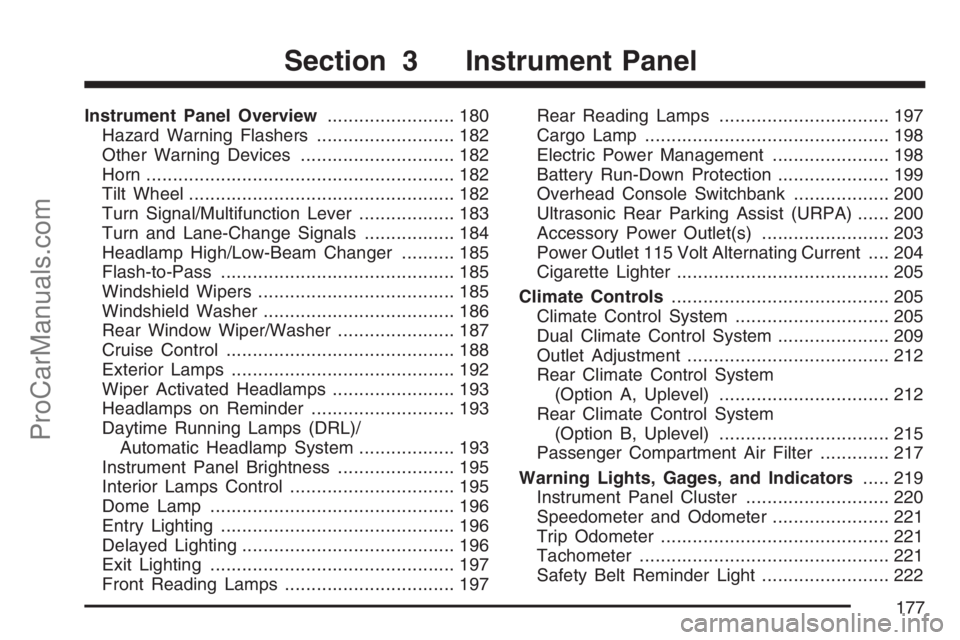
Instrument Panel Overview........................ 180
Hazard Warning Flashers.......................... 182
Other Warning Devices............................. 182
Horn.......................................................... 182
Tilt Wheel.................................................. 182
Turn Signal/Multifunction Lever.................. 183
Turn and Lane-Change Signals................. 184
Headlamp High/Low-Beam Changer.......... 185
Flash-to-Pass............................................ 185
Windshield Wipers..................................... 185
Windshield Washer.................................... 186
Rear Window Wiper/Washer...................... 187
Cruise Control........................................... 188
Exterior Lamps.......................................... 192
Wiper Activated Headlamps....................... 193
Headlamps on Reminder........................... 193
Daytime Running Lamps (DRL)/
Automatic Headlamp System.................. 193
Instrument Panel Brightness...................... 195
Interior Lamps Control............................... 195
Dome Lamp.............................................. 196
Entry Lighting............................................ 196
Delayed Lighting........................................ 196
Exit Lighting.............................................. 197
Front Reading Lamps................................ 197Rear Reading Lamps................................ 197
Cargo Lamp.............................................. 198
Electric Power Management...................... 198
Battery Run-Down Protection..................... 199
Overhead Console Switchbank.................. 200
Ultrasonic Rear Parking Assist (URPA)...... 200
Accessory Power Outlet(s)........................ 203
Power Outlet 115 Volt Alternating Current.... 204
Cigarette Lighter........................................ 205
Climate Controls......................................... 205
Climate Control System............................. 205
Dual Climate Control System..................... 209
Outlet Adjustment...................................... 212
Rear Climate Control System
(Option A, Uplevel)................................ 212
Rear Climate Control System
(Option B, Uplevel)................................ 215
Passenger Compartment Air Filter............. 217
Warning Lights, Gages, and Indicators..... 219
Instrument Panel Cluster........................... 220
Speedometer and Odometer...................... 221
Trip Odometer........................................... 221
Tachometer............................................... 221
Safety Belt Reminder Light........................ 222
Section 3 Instrument Panel
177
ProCarManuals.com
Page 178 of 570
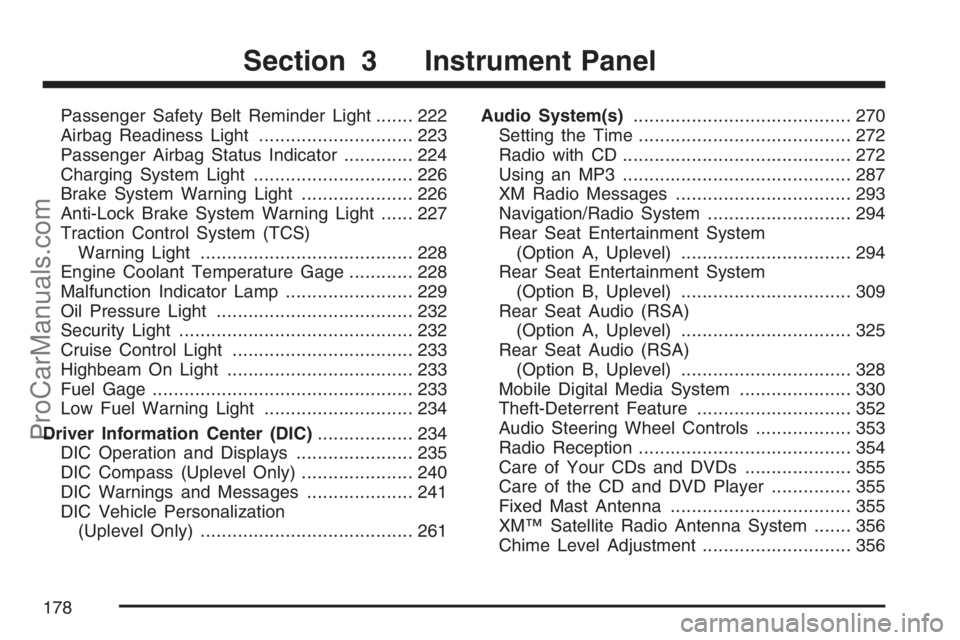
Passenger Safety Belt Reminder Light....... 222
Airbag Readiness Light............................. 223
Passenger Airbag Status Indicator............. 224
Charging System Light.............................. 226
Brake System Warning Light..................... 226
Anti-Lock Brake System Warning Light...... 227
Traction Control System (TCS)
Warning Light........................................ 228
Engine Coolant Temperature Gage............ 228
Malfunction Indicator Lamp........................ 229
Oil Pressure Light..................................... 232
Security Light............................................ 232
Cruise Control Light.................................. 233
Highbeam On Light................................... 233
Fuel Gage................................................. 233
Low Fuel Warning Light............................ 234
Driver Information Center (DIC).................. 234
DIC Operation and Displays...................... 235
DIC Compass (Uplevel Only)..................... 240
DIC Warnings and Messages.................... 241
DIC Vehicle Personalization
(Uplevel Only)........................................ 261Audio System(s)......................................... 270
Setting the Time........................................ 272
Radio with CD........................................... 272
Using an MP3........................................... 287
XM Radio Messages................................. 293
Navigation/Radio System........................... 294
Rear Seat Entertainment System
(Option A, Uplevel)................................ 294
Rear Seat Entertainment System
(Option B, Uplevel)................................ 309
Rear Seat Audio (RSA)
(Option A, Uplevel)................................ 325
Rear Seat Audio (RSA)
(Option B, Uplevel)................................ 328
Mobile Digital Media System..................... 330
Theft-Deterrent Feature............................. 352
Audio Steering Wheel Controls.................. 353
Radio Reception........................................ 354
Care of Your CDs and DVDs.................... 355
Care of the CD and DVD Player............... 355
Fixed Mast Antenna.................................. 355
XM™ Satellite Radio Antenna System....... 356
Chime Level Adjustment............................ 356
Section 3 Instrument Panel
178
ProCarManuals.com
Page 181 of 570
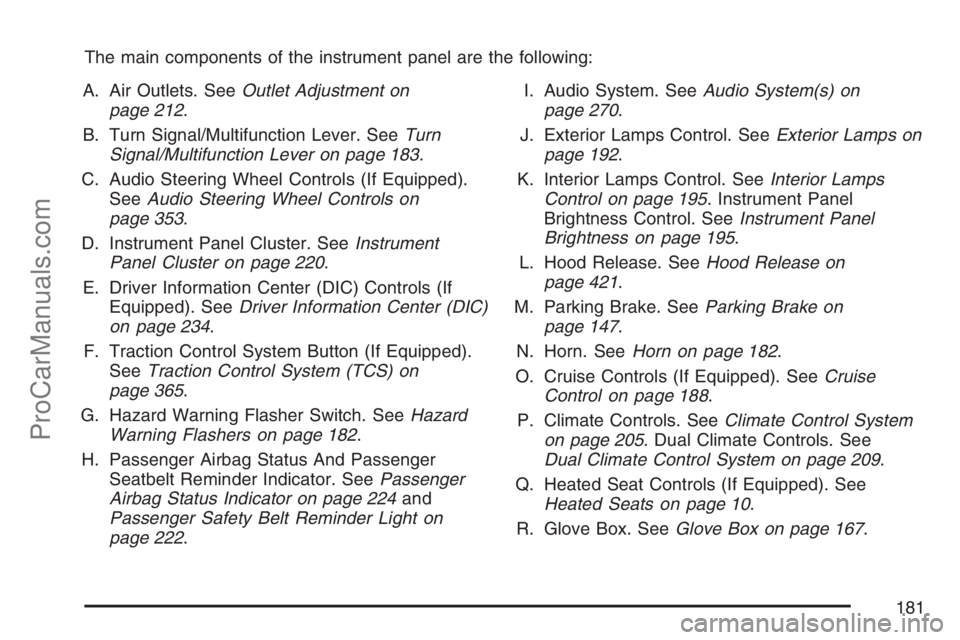
The main components of the instrument panel are the following:
A. Air Outlets. SeeOutlet Adjustment on
page 212.
B. Turn Signal/Multifunction Lever. SeeTurn
Signal/Multifunction Lever on page 183.
C. Audio Steering Wheel Controls (If Equipped).
SeeAudio Steering Wheel Controls on
page 353.
D. Instrument Panel Cluster. SeeInstrument
Panel Cluster on page 220.
E. Driver Information Center (DIC) Controls (If
Equipped). SeeDriver Information Center (DIC)
on page 234.
F. Traction Control System Button (If Equipped).
SeeTraction Control System (TCS) on
page 365.
G. Hazard Warning Flasher Switch. SeeHazard
Warning Flashers on page 182.
H. Passenger Airbag Status And Passenger
Seatbelt Reminder Indicator. SeePassenger
Airbag Status Indicator on page 224and
Passenger Safety Belt Reminder Light on
page 222.I. Audio System. SeeAudio System(s) on
page 270.
J. Exterior Lamps Control. SeeExterior Lamps on
page 192.
K. Interior Lamps Control. SeeInterior Lamps
Control on page 195. Instrument Panel
Brightness Control. SeeInstrument Panel
Brightness on page 195.
L. Hood Release. SeeHood Release on
page 421.
M. Parking Brake. SeeParking Brake on
page 147.
N. Horn. SeeHorn on page 182.
O. Cruise Controls (If Equipped). SeeCruise
Control on page 188.
P. Climate Controls. SeeClimate Control System
on page 205. Dual Climate Controls. See
Dual Climate Control System on page 209.
Q. Heated Seat Controls (If Equipped). See
Heated Seats on page 10.
R. Glove Box. SeeGlove Box on page 167.
181
ProCarManuals.com
Page 188 of 570

Cruise Control
{CAUTION:
Cruise control can be dangerous where
you cannot drive safely at a steady speed.
So, do not use your cruise control on
winding roads or in heavy traffic.
Cruise control can be dangerous on
slippery roads. On such roads, fast
changes in tire traction can cause
excessive wheel slip, and you could lose
control. Do not use cruise control on
slippery roads.If your vehicle has
cruise control, the lever
is located below the
windshield wiper control
on the right side of
the steering wheel.
QRES + (Resume/Accelerate):Push the lever
up to resume the cruise control speed, or to
accelerate when passing another vehicle.
J(CRUISE CONTROL) ON/OFFq:Press the
button on the end of the lever to turn the cruise
control on. Press it again to turn cruise control off.
RSET — (Set/Coast/Decelerate):Push the
lever down to set the cruise speed. If the cruise
speed is already set this position can be used
to coast or decelerate from a higher speed.
CANCEL
R:Pull the lever to cancel the cruise
control speed.
188
ProCarManuals.com
Page 189 of 570
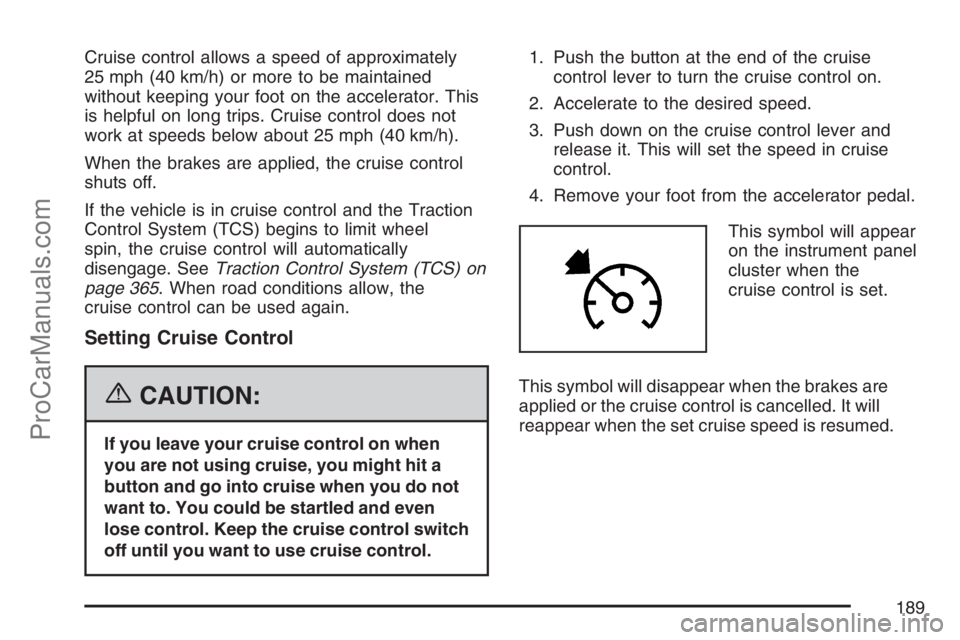
Cruise control allows a speed of approximately
25 mph (40 km/h) or more to be maintained
without keeping your foot on the accelerator. This
is helpful on long trips. Cruise control does not
work at speeds below about 25 mph (40 km/h).
When the brakes are applied, the cruise control
shuts off.
If the vehicle is in cruise control and the Traction
Control System (TCS) begins to limit wheel
spin, the cruise control will automatically
disengage. SeeTraction Control System (TCS) on
page 365. When road conditions allow, the
cruise control can be used again.
Setting Cruise Control
{CAUTION:
If you leave your cruise control on when
you are not using cruise, you might hit a
button and go into cruise when you do not
want to. You could be startled and even
lose control. Keep the cruise control switch
off until you want to use cruise control.1. Push the button at the end of the cruise
control lever to turn the cruise control on.
2. Accelerate to the desired speed.
3. Push down on the cruise control lever and
release it. This will set the speed in cruise
control.
4. Remove your foot from the accelerator pedal.
This symbol will appear
on the instrument panel
cluster when the
cruise control is set.
This symbol will disappear when the brakes are
applied or the cruise control is cancelled. It will
reappear when the set cruise speed is resumed.
189
ProCarManuals.com
Page 190 of 570
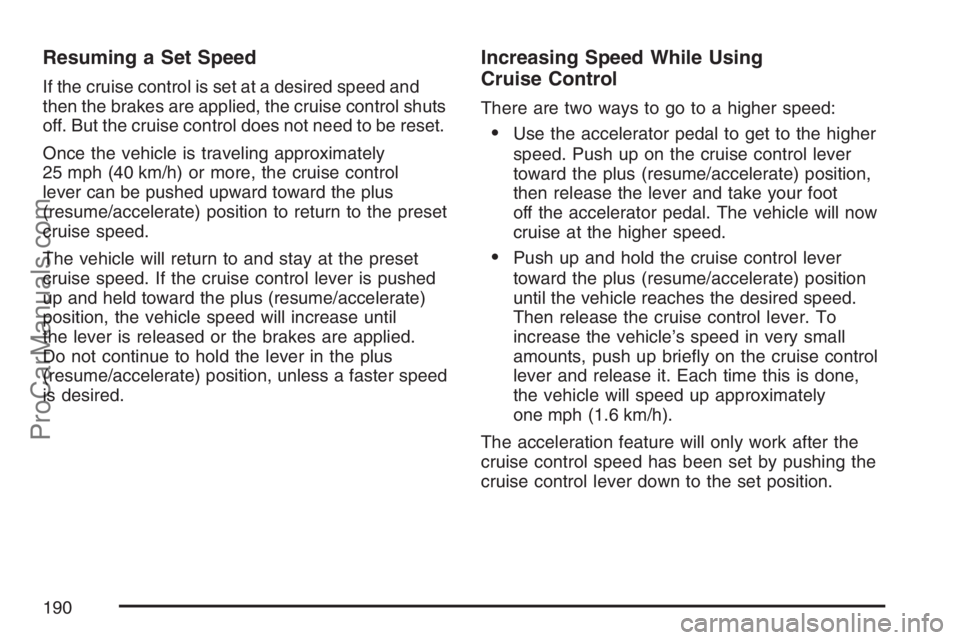
Resuming a Set Speed
If the cruise control is set at a desired speed and
then the brakes are applied, the cruise control shuts
off. But the cruise control does not need to be reset.
Once the vehicle is traveling approximately
25 mph (40 km/h) or more, the cruise control
lever can be pushed upward toward the plus
(resume/accelerate) position to return to the preset
cruise speed.
The vehicle will return to and stay at the preset
cruise speed. If the cruise control lever is pushed
up and held toward the plus (resume/accelerate)
position, the vehicle speed will increase until
the lever is released or the brakes are applied.
Do not continue to hold the lever in the plus
(resume/accelerate) position, unless a faster speed
is desired.
Increasing Speed While Using
Cruise Control
There are two ways to go to a higher speed:
Use the accelerator pedal to get to the higher
speed. Push up on the cruise control lever
toward the plus (resume/accelerate) position,
then release the lever and take your foot
off the accelerator pedal. The vehicle will now
cruise at the higher speed.
Push up and hold the cruise control lever
toward the plus (resume/accelerate) position
until the vehicle reaches the desired speed.
Then release the cruise control lever. To
increase the vehicle’s speed in very small
amounts, push up brie�y on the cruise control
lever and release it. Each time this is done,
the vehicle will speed up approximately
one mph (1.6 km/h).
The acceleration feature will only work after the
cruise control speed has been set by pushing the
cruise control lever down to the set position.
190
ProCarManuals.com
Page 191 of 570
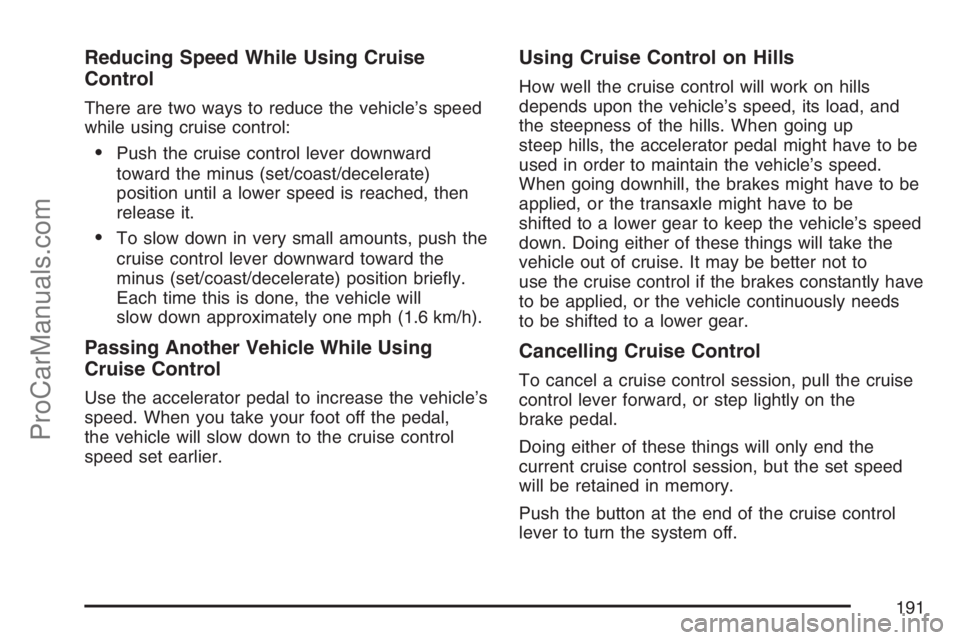
Reducing Speed While Using Cruise
Control
There are two ways to reduce the vehicle’s speed
while using cruise control:
Push the cruise control lever downward
toward the minus (set/coast/decelerate)
position until a lower speed is reached, then
release it.
To slow down in very small amounts, push the
cruise control lever downward toward the
minus (set/coast/decelerate) position brie�y.
Each time this is done, the vehicle will
slow down approximately one mph (1.6 km/h).
Passing Another Vehicle While Using
Cruise Control
Use the accelerator pedal to increase the vehicle’s
speed. When you take your foot off the pedal,
the vehicle will slow down to the cruise control
speed set earlier.
Using Cruise Control on Hills
How well the cruise control will work on hills
depends upon the vehicle’s speed, its load, and
the steepness of the hills. When going up
steep hills, the accelerator pedal might have to be
used in order to maintain the vehicle’s speed.
When going downhill, the brakes might have to be
applied, or the transaxle might have to be
shifted to a lower gear to keep the vehicle’s speed
down. Doing either of these things will take the
vehicle out of cruise. It may be better not to
use the cruise control if the brakes constantly have
to be applied, or the vehicle continuously needs
to be shifted to a lower gear.
Cancelling Cruise Control
To cancel a cruise control session, pull the cruise
control lever forward, or step lightly on the
brake pedal.
Doing either of these things will only end the
current cruise control session, but the set speed
will be retained in memory.
Push the button at the end of the cruise control
lever to turn the system off.
191
ProCarManuals.com
Page 192 of 570

Erasing Speed Memory
When the cruise control or the ignition is turned
off, the cruise control set speed memory is erased.
Exterior Lamps
The control to the left of
the steering column
operates the exterior
lamps.
9(Off):Turn the control to this position to
toggle off all lamps. This is a momentary control
that will spring back to AUTO when released.
This momentary control will turn the automatic
headlamps and/or the Daytime Running Lamps on
and off for U.S. vehicles. For vehicles �rst sold
in Canada, this is only true when the transaxle is in
PARK (P).AUTO (Automatic):Turn the control to this
position to set your headlamps in automatic mode.
AUTO mode, if enabled, will turn the exterior
lamps on and off automatically depending on how
much light is available outside the vehicle.
Due to the momentary switch design, your
automatic lights may be disabled even if the
control is in the AUTO position.
;(Parking Lamps):Turn the control to this
position to turn on the parking lamps together with
the following:
Taillamps
Instrument Panel Lights
5(Headlamps):Turn the control to this position
to turn on the headlamps, together with the
previously listed lamps and lights.
192
ProCarManuals.com
Page 233 of 570

Cruise Control Light
This light comes on
whenever you set your
cruise control.
The light will go out when the cruise control is
turned off. SeeCruise Control on page 188
for more information.
Highbeam On Light
This light will come on
when the high-beam
headlamps or the
Flash-to-Pass feature is
in use.
SeeHeadlamp High/Low-Beam Changer on
page 185.
Fuel Gage
When the indicator nears empty, you still have a
little fuel left, but you should get more soon.
Your fuel gage tells you about how much fuel you
have left when the ignition is on.
United StatesCanada
233
ProCarManuals.com
Page 366 of 570
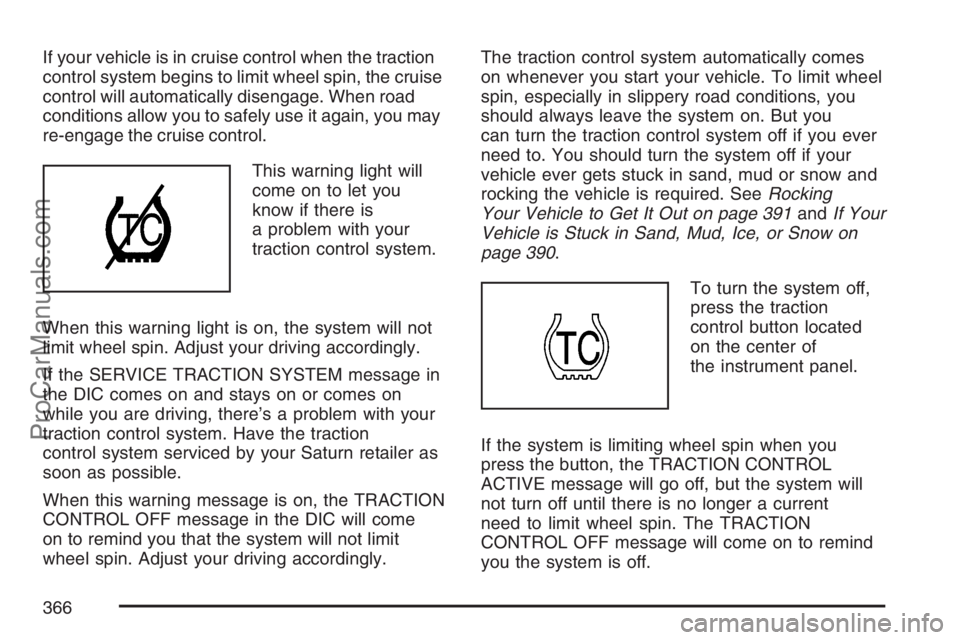
If your vehicle is in cruise control when the traction
control system begins to limit wheel spin, the cruise
control will automatically disengage. When road
conditions allow you to safely use it again, you may
re-engage the cruise control.
This warning light will
come on to let you
know if there is
a problem with your
traction control system.
When this warning light is on, the system will not
limit wheel spin. Adjust your driving accordingly.
If the SERVICE TRACTION SYSTEM message in
the DIC comes on and stays on or comes on
while you are driving, there’s a problem with your
traction control system. Have the traction
control system serviced by your Saturn retailer as
soon as possible.
When this warning message is on, the TRACTION
CONTROL OFF message in the DIC will come
on to remind you that the system will not limit
wheel spin. Adjust your driving accordingly.The traction control system automatically comes
on whenever you start your vehicle. To limit wheel
spin, especially in slippery road conditions, you
should always leave the system on. But you
can turn the traction control system off if you ever
need to. You should turn the system off if your
vehicle ever gets stuck in sand, mud or snow and
rocking the vehicle is required. SeeRocking
Your Vehicle to Get It Out on page 391andIf Your
Vehicle is Stuck in Sand, Mud, Ice, or Snow on
page 390.
To turn the system off,
press the traction
control button located
on the center of
the instrument panel.
If the system is limiting wheel spin when you
press the button, the TRACTION CONTROL
ACTIVE message will go off, but the system will
not turn off until there is no longer a current
need to limit wheel spin. The TRACTION
CONTROL OFF message will come on to remind
you the system is off.
366
ProCarManuals.com